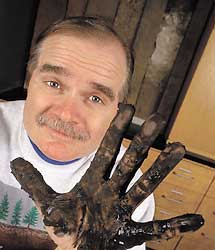
The Mudman
A framed 8-by-10 photograph in Jimmie Richardson's Walster Hall office on the North Dakota State University campus tells it all.
In the 1992 snapshot, Richardson and two colleagues mug for the camera from the bottom of a two-foot trench in a northern Illinois wetland test plot, mud plastered to their thighs above their rubber boots, ear-to-ear grins on their faces.
It captures one of those near-perfect moments in the career of a field scientist who can't contain his excitement when discussing landscapes; who quite seriously applies words such as beauty and elegance to soils; and whose work led to what has been called the most significant advance in soil science in decades.
Richardson started examining wetland soils, water movement in landscapes and the dynamics of salinization when he arrived at NDSU in 1978. By the mid-'80s he had demonstrated how hydrology affects soils and how soil morphology can be used to interpret water movement through soils and landscapes. His methods have been adopted around the world and set the standard in the United States for determining hydric soils and delineating wetlands.
The self-described hillbilly with a Northern accent.Hence the name Jimmie, he says with a grin has been developing what he calls his land ethic since he was a scamp backpacking and hunting in the Rocky Mountain ranges of northern Idaho. His father, a lumberman, taught him to observe mountain landscapes to learn what kinds of trees grew where and why.
His love of natural forms took him to the University of Idaho to study geology. While pursuing his master's degree at the University of Oklahoma, Richardson ran into an ideology that was more concerned with petroleum discovery than land and water conservation. He switched to a subfield of geology called geomorphology and went on to earn his doctorate in soil genesis and morphology at Iowa State University.
I believe there should be a tomorrow, he says, so I've spent my life trying to develop methods and systems that preserve the quality of our water, our earth and its soils for future generations.
He's pursued those goals with seemingly boundless energy and what can only be described as an infectious glee. People who know him most often use words like dynamic, intense and passionate.
Richardson carries those qualities from the field into the classroom, where his enthusiasm for the material enthralls and motivates students. They, in turn, regularly rate him as the best, most knowledgeable and enjoyable instructor they've had. And he expects as much from them as he does from himself.
I'm not going to fool around with anybody I don't think is motivated to work, who doesn't believe in conservation and that water and soils are important, he says. I tell them they have a future, that they're important and that they'll be even more important when they have this done and go abouttheir business.
Richardson works so hard that at times his department chair has to rein him in. He can get pretty wound up about his projects, says Lynn Brun, professor of soil science. He is one of the department faculty I have to remind to slow down for fear of burn out or physically doing damage to himself.
His idea of slowing down is to head back to the Selkirk and Purcell ranges in the northern Rockies of Idaho a couple of times each year for four- to five-day solo backpacking trips.
I can really get it together when I'm back hiking by myself, Richardson says. I love the feel of the wind in the mountains, looking at the scenery and discovering what's around the next corner. I need those solo times, but there's always a time when I need to come back and talk to people again.
Then it's back to his daily routine. Each day begins at 4 a.m. with a five- to six-mile run, perhaps a weight workout at the YMCA, breakfast and then on to his students and research.
He has the perfect appointment because he loves to teach and he's super interested in what he's doing in terms of research and outreach, says his wife, Kathie, the agricultural sciences librarian in the NDSU Libraries. He just has the perfect job, and I think he knows that.
Finding happiness in his career is something he has encouraged in his two children, Kimberly, a teacher at Minneapolis North High School, and Erik, a senior studying geography at New Mexico State University.
When the kids aren't home for a visit, and when he's not speaking to agriculture and professional groups, Richardson is out snowshoeing, cross-country skiing or camping, even in cold winter weather. I like to look at the world every day, he says. In the evenings he shares cooking duties with Kathie and spends his time reading history, especially about the movement of peoples across the landscapes he loves so well.
M. Fredricks

































